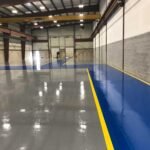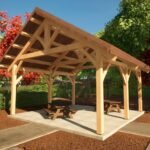From sleek infinity pools to natural swimming ponds, modern pools offer more options than ever before.
Whether you’re dreaming of a backyard oasis or planning a major home upgrade, choosing the right type of swimming pool is one of the most important decisions you’ll make. Beyond just aesthetics, your choice impacts everything from budget and maintenance to property value and daily use.
There’s no one-size-fits-all solution. Some pools are built for fitness, others for relaxation or entertaining. Certain designs blend seamlessly into your landscape, while others stand out as luxury features. Add in considerations like climate, yard size, and long-term maintenance—and suddenly, choosing a pool can feel overwhelming.
That’s why we’ve created this complete guide to the different types of swimming pools, broken down by construction method, design style, and special features. Whether you’re considering a low-cost above-ground option, a customizable concrete inground build, or an eco-friendly natural pool, this article will help you understand the pros, cons, and ideal uses of each.
What You’ll Learn:
- Key differences between inground and above-ground pools
- Pros and cons of concrete, vinyl, and fiberglass options
- Popular designs like lap pools, infinity edges, and natural ponds
- High-tech and specialty pools, including smart pools and spools
- Tips to match the right pool type to your budget, lifestyle, and property
By the end of this guide, you’ll be ready to move forward with confidence—knowing you’ve made an informed decision tailored to your needs.
Pool Types by Construction
When it comes to building a pool, construction type is the most fundamental choice you’ll make. Each type varies in cost, installation time, durability, and maintenance. Let’s break down the most common pool construction options:
1. Inground Pools
Concrete Pools (Gunite/Shotcrete)
Concrete pools—often referred to as gunite or shotcrete pools—are the most durable and customizable inground pool option. They are built by spraying concrete over a steel-reinforced framework, allowing for virtually any shape or depth.
Pros:
- Fully customizable design
- Extremely durable and long-lasting
- Ideal for luxury and custom builds
Cons:
- Higher initial cost
- Long construction time (2–3 months)
- Requires frequent surface maintenance (resurfacing every 10–15 years)
Best for: Homeowners wanting a high-end, custom design with long-term use in mind.
2. Vinyl-Liner Pools
These inground pools use a flexible vinyl liner over a steel or polymer frame. They’re among the most budget-friendly inground options.
Pros:
- Lower upfront cost
- Faster installation (2–3 weeks)
- Smooth surface finish
Cons:
- Liner can tear or wrinkle over time
- Shorter lifespan (vinyl liners last 7–10 years)
- Limited in terms of shape customization
Best for: Budget-conscious families who want an inground pool without the concrete price tag.
3. Fiberglass Pools
Fiberglass pools are pre-manufactured shells that are delivered and installed in one piece. They’re quick to install and low maintenance.
Pros:
- Fast installation (as little as 1 week)
- Low maintenance (smooth, algae-resistant surface)
- Durable with minimal repairs
Cons:
- Limited shapes and sizes
- Higher transportation cost
- Difficult to modify after installation
Best for: Homeowners looking for a low-maintenance, quick-installation option.

4. Above-Ground Pools
Steel or Aluminum Frame Pools
These are the most affordable and quickest to set up. They sit on top of the ground and often come in DIY kits.
Pros:
- Budget-friendly
- DIY installation possible
- Can be disassembled or relocated
Cons:
- Shorter lifespan (5–15 years)
- Lower resale value
- Not as visually appealing
Best for: Renters or those wanting a temporary, cost-effective pool.
5. Semi-Inground Pools
A hybrid between inground and above-ground, semi-inground pools are partially buried in the ground, making them ideal for sloped backyards.
Pros:
- Blends with landscaping
- Less expensive than full inground
- Easier installation on uneven terrain
Cons:
- More expensive than traditional above-ground
- Fewer design options than full inground
Best for: Sloped yards or homeowners looking for a middle-ground option in aesthetics and cost.
Pool Types by Design
While construction defines the structure, pool design determines function and aesthetics. Whether you’re focused on fitness, relaxation, or eco-conscious living, there’s a pool design to match your lifestyle.
1. Lap Pools
These pools are long and narrow, typically 40+ feet in length, and designed specifically for swimming laps.
Pros:
- Ideal for daily exercise
- Space-efficient for narrow yards
- Simple, modern look
Cons:
- Limited recreational use
- May not suit families with kids
Best for: Fitness-focused individuals or swimmers.
2. Infinity Pools
Infinity edge or “vanishing edge” pools feature one or more walls that appear to blend seamlessly into the horizon.

Pros:
- Stunning visual appeal
- Adds luxury to your property
- Great for scenic views
Cons:
- High construction cost
- Requires complex engineering and site grading
- Higher water evaporation
Best for: High-end homes, especially those on elevated sites with views.
3. Natural Swimming Pools
These pools use biological filters and plants instead of chemicals to clean the water. They resemble ponds or natural lagoons.
Pros:
- Chemical-free and eco-friendly
- Unique, organic look
- Doubles as a garden feature
Cons:
- Higher initial design complexity
- Regular care needed for the plant ecosystem
- Less control over water clarity
Best for: Eco-conscious homeowners who prefer a natural aesthetic.
4. Plunge Pools
Compact and designed primarily for relaxation or quick cool-downs, plunge pools are ideal for small yards.
Pros:
- Space-saving
- Lower construction cost
- Can be heated for year-round use
Cons:
- Limited space for swimming
- May not suit larger families
Best for: Urban homes or anyone looking for a small, low-maintenance pool.
Specialty Pools
Beyond traditional construction and design, today’s homeowners have access to specialty pool options that enhance comfort, efficiency, and enjoyment. These innovations cater to specific preferences—from spa-like relaxation to cutting-edge automation.
1. Saltwater vs. Chlorine Pools
One of the biggest decisions for pool owners is choosing between a saltwater and a chlorine sanitizing system. Each has its own maintenance routine, cost implications, and impact on the swimming experience.
a. Saltwater Pools
Saltwater systems use a salt chlorine generator to convert salt into chlorine, providing a gentler, more natural feel to the water.
Pros:
- Softer water on skin and eyes
- Lower chemical levels
- Reduced chlorine odor
Cons:
- Higher upfront cost for the salt system
- Salt can be corrosive to certain materials
- Requires specific maintenance and cell replacement
Best for: Those with sensitive skin or who prefer a low-chlorine experience.
b. Chlorine Pools
Traditional pools use added chlorine tablets or liquids to sanitize water and prevent algae growth.
Pros:
- Lower initial setup cost
- Easy to manage with widely available products
- Fast-acting against bacteria and algae
Cons:
- Stronger chemical smell
- Can cause skin and eye irritation
- Requires frequent testing and adjustments
Best for: Pool owners who want a straightforward, budget-friendly system with familiar upkeep.
2. Smart Pools
Smart pools use advanced technology to automate everything from cleaning and heating to chemical balance. These are ideal for homeowners who want convenience and control.
Pros:
- Automated chemical monitoring and dosing
- Remote control via smartphone or smart home systems
- Integration with robotic cleaners and timers
Cons:
- Higher upfront equipment cost
- Requires tech-savvy setup and occasional updates
Best for: Tech-forward users who want hands-free pool care and energy efficiency.
3. Spools (Spa + Pool Combos)
A spool is a hybrid between a spa and a pool, offering the best of both worlds in a compact design.
Pros:
- Space-saving and versatile
- Heated water and jets for relaxation
- Usable year-round in many climates
Cons:
- Not ideal for full swimming
- Can be costly for its small size
Best for: Small properties or those looking to combine hydrotherapy and casual cooling in one.
Conclusion
With so many types of swimming pools available—each with unique benefits in terms of cost, design, maintenance, and aesthetics—the right pool depends on your lifestyle, budget, and available space.
Whether you’re drawn to the durability of a concrete inground pool, the elegance of an infinity edge, or the eco-friendliness of a natural swimming pool, today’s pool options allow you to customize your outdoor experience like never before.
Ready to choose your perfect pool?
Check out our complete guide to selecting the right swimming pool and make a confident, informed decision for your home.
Frequently Asked Questions (FAQ)
- What are the main types of swimming pools?
The main types of swimming pools include inground pools (concrete, vinyl, and fiberglass), above-ground pools, lap pools, infinity pools, natural swimming pools, plunge pools, and spools (spa + pool hybrids). Each type has unique pros and cons in terms of cost, design, and maintenance.
2. What is the difference between inground and above-ground pools?
Inground pools are built into the ground and are typically more durable and customizable but come with higher costs and longer installation times. Above-ground pools sit on the ground’s surface, are more affordable and quicker to set up, but often have a shorter lifespan and fewer design options.
3. Which pool type is best for small backyards?
For smaller spaces, plunge pools, spools, and compact fiberglass pools are ideal. These provide the relaxation and cooling benefits of a larger pool without taking up much space. Lap pools can also be a good option for narrow yards focused on fitness.
4. Are saltwater pools better than chlorine pools?
Saltwater pools are gentler on the skin and eyes, have lower chlorine levels, and require less frequent chemical adjustment. However, they cost more upfront and may corrode certain pool materials. Chlorine pools are more budget-friendly and easier to manage with off-the-shelf products but require regular maintenance and testing.
5. How long does each type of pool last?
- Concrete pools: 30–50 years with resurfacing every 10–15 years
- Fiberglass pools: 20–30 years with minimal maintenance
- Vinyl-liner pools: 7–10 years before liner replacement
- Above-ground pools: 5–15 years depending on material quality
6. What is the most low-maintenance pool type?
Fiberglass pools are generally the most low-maintenance. Their smooth, nonporous surface resists algae and requires fewer chemicals, making upkeep easier and less time-consuming than concrete or vinyl.
7. Can I install a pool on a sloped yard?
Yes. Semi-inground pools and custom concrete inground pools are well-suited for sloped yards. These options allow partial burial into the slope, offering a more natural look and structural stability.
8. Do swimming pools increase home value?
A well-designed, properly maintained inground pool can increase home value—especially in warmer climates. However, the value also depends on local market trends, buyer preferences, and how well the pool integrates with the property.
9. What is a natural swimming pool?
A natural swimming pool uses plants and biological filters instead of chemicals to clean the water. It resembles a pond and offers an eco-friendly, chemical-free swimming experience.








Leave a Reply